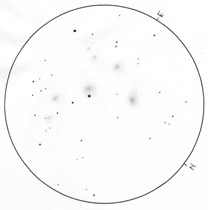 There are few experiences in amateur astronomy as impressive as seeing a bunch of galaxies in one field of view. And that is what my drawing presents, seven galaxies in one eyepiece field. This galaxy cluster is located in western Pegasus about a degree southeast of 4.2 magnitude Xi (46) Pegasi. The cluster is anchored by NGC 7385. It's the 12.0 magnitude misty oval adjacent to the 11th magnitude star near the center of my sketch, which captures 122X and 173X views in the big Obsession. NGC 7386 is the other bright galaxy. Its 2' by 1' form stands 5'.5 north of NGC 7385 and is aligned roughly east to west. NGC 7386 is a 12.3 magnitude spiral-type galaxy. NGC 7387 is a 30" diameter patch of haze, the brightest of three galaxies east of NGC 7385. This 14.0 magnitude transitional galaxy is framed by a close pair of stars, 10.5 magnitude and 11.0 magnitude, 4' to the east-southeast. Another stellar pairing, this duo featuring 13th magnitude embers, resides about the same distance to the northeast.
There are few experiences in amateur astronomy as impressive as seeing a bunch of galaxies in one field of view. And that is what my drawing presents, seven galaxies in one eyepiece field. This galaxy cluster is located in western Pegasus about a degree southeast of 4.2 magnitude Xi (46) Pegasi. The cluster is anchored by NGC 7385. It's the 12.0 magnitude misty oval adjacent to the 11th magnitude star near the center of my sketch, which captures 122X and 173X views in the big Obsession. NGC 7386 is the other bright galaxy. Its 2' by 1' form stands 5'.5 north of NGC 7385 and is aligned roughly east to west. NGC 7386 is a 12.3 magnitude spiral-type galaxy. NGC 7387 is a 30" diameter patch of haze, the brightest of three galaxies east of NGC 7385. This 14.0 magnitude transitional galaxy is framed by a close pair of stars, 10.5 magnitude and 11.0 magnitude, 4' to the east-southeast. Another stellar pairing, this duo featuring 13th magnitude embers, resides about the same distance to the northeast.
Those are the first four members of this septet. Let's look at the remaining four. Two reside about 5' south of NGC 7387 Northernmost of this duo is 20" diameter NGC 7389. With a blue magnitude of 14.8, this barred spiral probably has a visual magnitude of about 14.0. That's not exactly in the bright column, but it's not nearly as intimidating as something closer to the 15.0 threshold. The 20" diameter smudge 2' to the southeast is NGC 7390. It has a blue magnitude of 15.1 and that's faint any way you slice it. The 9.4 magnitude star at the southeast field boundary is SAO 108210. The final two galaxies are stationed southwest of NGC 7385. The first is NGC 7383, a 1' by 0'.5 nebulous haze with an east-west alignment. Two rows of three stars are lined up about 4' to the south. A 12th magnitude ember glows 3' to the northeast. And a somewhat fainter star is seen 2'.5 to the west-northwest.
That leaves just one galaxy in the cluster to explore. This would be LEDA 95571. LEDA 95571 (aka GIN 664 and MAC 2249+1129) is seen intermittently with averted vision. It's the 10" diameter fuzzy spot 3'.5 west of NGC 7383. It's a tiny little galaxy but has a high enough surface brightness that it can be seen with substantial magnification in a large aperture scope. A faint star of unknown brightness is seen immediately to the southwest.
All seven galaxies have radial velocities in the 7100 to 8300 km per second/megaparsec with four of the group moving between 7700 to 7900 km per second/megaparsec. This suggest a distance of 360 to 400 million light-years. Imagine that, the light we see in our telescopes began its journey to Earth millions of years before humanity was even a glimmer in God's eye. |
![]()
![]()
